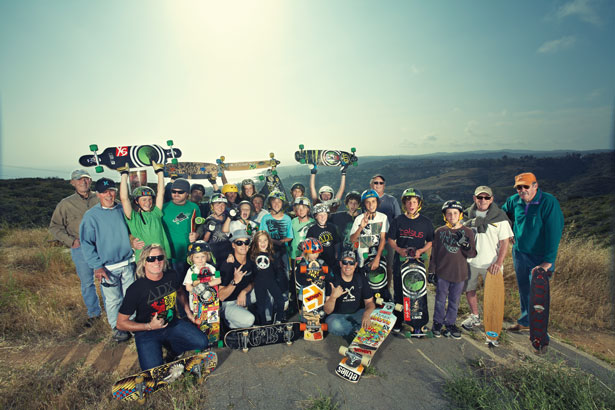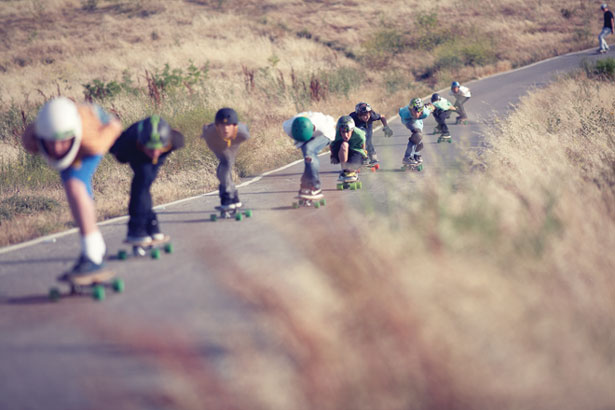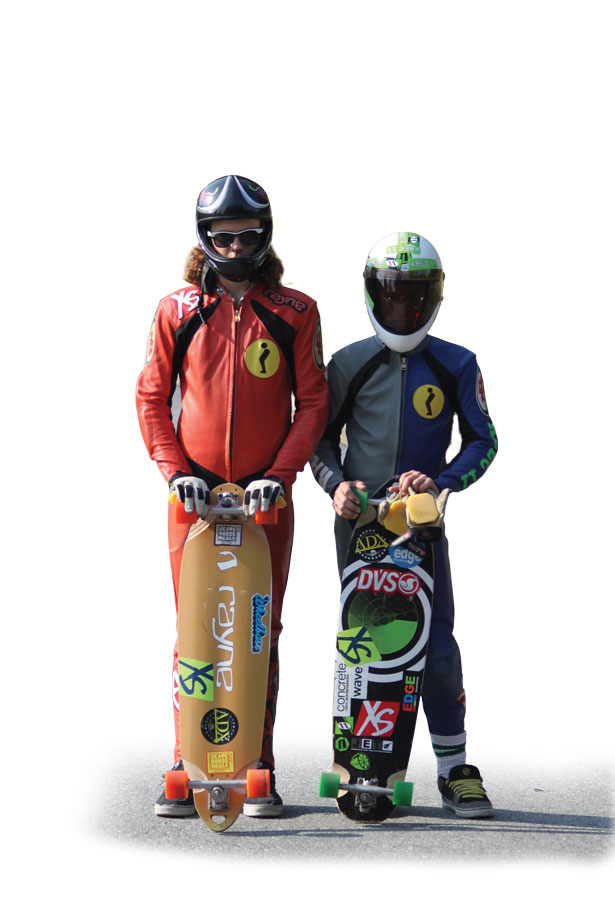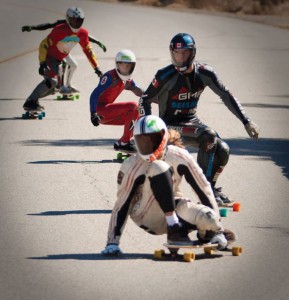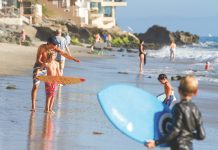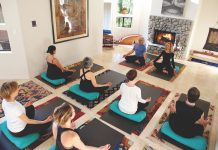All Downhill From Here?
As Laguna Beach continues to mull over and enforce new rules, residents discuss the pros, cons and alternatives to banning downhill skateboarding from select streets. By Dana Nichols
After sussing out the heated issue in city hall this spring, local skateboarders held onto the right to ride (most of) Laguna Beach’s streets. But a year later, more kids are riding urethane wheels than ever before. Not everyone shares their enthusiasm, and new questions continue to arise. Are there still better solutions?
Most of the town’s tourists will likely never encounter speedboarders—a good or bad thing depending on whom you ask. They’ll never witness the vision of teenagers in a blur (sometimes as fast as cars) unless they venture into hillside neighborhood streets, where they’ll see young athletes waiting at bus stops, perfecting controlled slides and bombing down residential thoroughfares.
“Laguna is special due to the numerous hills in such close proximity,” explains Jake Fast, 15, who is sponsored by Rayne Longboards and XS Energy. “It’s a skater’s paradise; people from all over know of the hills here and want to ride them.”
Since 2010, the number of downhill skateboarders in Laguna Beach has grown from about 20 to 200, insiders say. The sport is on the upswing, from the hills of Southern California to countries 20 time zones away.
The fact that Laguna Beach made it a civil violation to skateboard on eight of the steepest streets last spring seems to have had little to no impact on the sport’s popularity; in fact, the media attention may have been a catapult. Laguna resident and two-time world downhill skateboarding champ Mark Golter, whose 6-year-old son Skyler is sponsored by Madrid Skateboards, says it’s the only city he knows of that has legalized downhill skateboarding. “They could’ve banned every hill but they didn’t. I know they banned eight hills but realistically, the way I look at it is they opened up hundreds of others. I think it’s a big move for the city to do that.”
The headline-making April 2011 legislation, which also restricts skaters’ speeds and requires helmets in Laguna Beach, was the outcome of a yearlong debate that began when a group of Bluebird Canyon residents grew so concerned with street safety that they campaigned to fully ban skateboarding in the entire town.
A drama unfolded in public flyers, private meetings, city hall debates, articles, letters to the editor and online rants. CBSNews.com called it “a classic California clash” in August 2010, with one side warning downhill skateboarding is a menace and a risk, and the other calling attention to slack drivers.
The Edge Boardshop opened two weeks after the legislation was made. Now, after more than a year in business, owner Mike Bornstein ships custom longboards and slide gloves from Asia to Dubai; he supports team riders in Costa Rica, Brazil, Australia, New Zealand and 13 on home turf; and he doesn’t worry about street bans negatively impacting sales. “If the city’s decision ends up saving one life, then it was worth it,” Mike says. “I’m more concerned about the safety of these kids than my business or hurting the industry. The sport is so strong, and growing so fast; there are other places people can skate.”
Streets are safer, according to Laguna Beach Police, announcing earlier this year that crashes went from 17 to seven since the legislation, including six months without any reported accidents. But closing off streets isn’t the end-all of the problem; it re-directs traffic.
Speed Check
Clara Frantz regularly sees skateboarders on her off-limits street. “A couple of days ago I encountered speedboarders flying down Bluebird Canyon Drive. They were swinging over to my lane,” she says. “Only because I was driving 15 miles an hour could I maneuver my car and escape an accident.” She’s also seen them on Morningside Drive. “It’s a good start by the city council, but now the speedboarders have moved to other steep hills and various neighborhoods are very concerned.” Both camps think the police department—with at least one officer on skateboard enforcement detail at all times—can have more of an impact by issuing citations. Aggressive ticketing only started this spring, says LBPD Civilian Supervisor Jim Beres. “In warning mode we were getting the kids acclimated to the way we’re doing things,” he says, referring to the time between May 5, 2011 and Jan. 31, 2012, when officers issued 46 warnings.
“My hope is that they’ll keep ticketing the troublemakers,” says Kimberly Young, a supportive mother of two skateboarders. She continues, “Every day, all over the place, the cops are constantly giving tickets to the kids, which is a good thing.”
The department has received about 200 complaint calls annually since 2010, but tickets are only written when officers actually see a violation occur. “Occasionally, we do get there in enough time,” Jim says. “It obviously happens because we’ve issued some.” This spring (between Feb. 28 and May 17, 2012) officers issued 38 citations and 11 courtesy notices for skateboarding violations citywide. Between May 2011 and 2012, a total of 84 citations were issued, Chief of Police Paul Workman reported to the city council on June 5, adding that it was not as many as he would like.
Where Are the Parents?
Skyline Drive is a $1 million view. Towering atop the town with ocean views, 122 driveways, 10 intersections and no sidewalk, it’s tough hiking, tricky driving, challenging speedboarding and dangerous for all of the aforementioned. Residents placed 19 complaint calls to police in the summer and fall of last year, so LBPD recommended adding the street to the “banned” list in February. Teen skaters held off the ban for 60 days by explaining to the city council that the current issue is actually unruly skaters, mostly groms under 13. But by May 17, 2012, 31 more complaints were received about skaters on Skyline, and the city council deemed it too dangerous not to ban.
“I don’t think Skyline Drive is the problem,” Sam Dameshek, 13, told council members in February. “I think that the kids think that they are ready and mature enough to do certain runs such as Skyline, which is advanced, fast, tight cornered and you have to be mature and a good skateboarder to skate it.”
Supportive parents, including Mark and Kimberly, took the effort grassroots, buying newspaper ad space and holding a safety info meeting in Bluebird Park—but for 75 kids in attendance, only 10 parents came. “I think there’s a lot of working parents—single parents—and so many of these kids are let loose with no guidelines,” says Chad Gibbs, “a cautious supporter” whose son Wyatt, 15, rides for ABEC 11 and Rayne. With the family garage as Laguna’s unofficial skateboarder hangout, Chad has to tell kids to go home every night; meanwhile, nonchalance in adults has increased. “The city council meetings at first were packed, but now this story is played out; a lot of people are burned out on it,” he says. “I’ve defended these guys from the beginning, but I’m also not oblivious [to the fact] that kids are putting their lives on the line. I think the city and the skateboarders need to find an alternative.”
Besides handing out more tickets, LBPD outreach is nearing an end point. They have organized meetings, gone to schools and skate shops, Jim says. “We’ve talked about this for a year and a half now. I don’t think anyone would say there’s been a lack of communication from the police department on this issue.” Specific streets are still monitored closely, including Park Avenue and Nyes Place, which each received a handful of complaint calls over the past year.
From her Park Avenue window, Karen Parker can see the memorial cross marking the site where Mark Leones, 28, was killed on his bicycle last October. The mother of two under 10 is constantly looking out for skateboarders. “Something could trip them up, and I don’t think they could stop. God forbid that one day I’m driving and they’re in front of my car and I’m responsible,” she says, agreeing that parents need to step up. “It’s not up to our city council to legislate against negligent parenting. I think parents need to step in and say, ‘Stop flying down the hill. Stop hitchhiking.’ In retrospect it’s going to look so stupid.”
Park Dreams
Laguna Beach skateboarding culture casts a wide net, including pro teens, industry insiders, church pastors, surfers on skateboards, skate legends, guys cruising to work and now, even a handful of stealth downhillers who try to skate under the radar. Since the ’90s, skatepark plans have come close, but never to fruition. Mark thinks that might change: “Now, with all these kids skating and no where to skate, I think the city’s forced to revisit the issue and designate a downhill area, or an area to build a skatepark. Having some areas in that park for sliding I think that would solve the whole thing.”
Brett Daly supports a skatepark after seeing kids exhibit a fearless, “I-own-the-road” attitude; he had the hood of his car slammed and dented by a deck-wielding skateboarder after a near-crash. “I was a kid once too—we didn’t have the laws, and the attorneys, and the parents who let kids do what they want to do; the kids are not being responsible,” the longtime resident says. “They’re absolute kamikazes. I think these kids should be off the street where somebody can supervise them.”
City council member Elizabeth Pearson says there appears to be about $300,000, which includes a gift of $100,000 for skatepark development. “I think that the city council has an open mind about a skatepark,” she says. “We would need to find a location for it and find out how much it would cost to build a park that our young people actually use before pursuing it. We’ve been told by some of the kids that they would prefer to skate on the various hills around Laguna Beach; so the concern is, is it something that would actually be used?”
Liability and cost concerns have quashed suggestions such as warning signs, water tower roads and designated skate times. Mark was denied permits for holding a sponsored event this year. A sanctioned event would be one of the best options when it comes to safety and liability, says personal injury attorney Robert McMahon: “If you had roads closed up, [and] the city takes over the street, I would anticipate that there would be insurance, and you could probably hold a skateboarding event with a greater degree of safety. The city has shut down streets for bike races and running events. It can be done.”
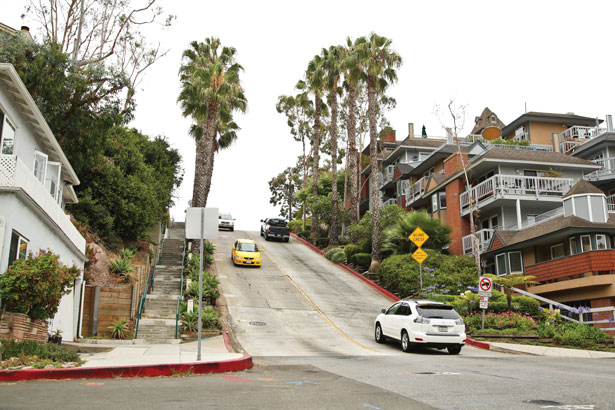 Whose Streets Are They Anyway?
Whose Streets Are They Anyway?
According to Caltrans, between 100 and 150 fatal bicycle collisions and 600 to 725 fatal pedestrian collisions occur each year. The Skaters for Public Skateparks organization reported 11 skateboard fatalities (six caused by a vehicle) in California in 2011.
“You don’t realize how dangerous it is ’til you’re not in a car,” says Rob Brink, Laguna resident and host of the “Weekend Buzz” on Tony Hawk’s YouTube RIDE Channel. He’s not a downhill skateboarder but points to drivers who talk on their cell phones and don’t stop at stop signs. “If we’re worried about safety, aren’t there bigger fish to fry? Where did the sense of entitlement come from, that if you own a car you own the space? If there’s no skatepark, then why does a car have the right of way over a skateboarder, or a bike or a pedestrian? It’s stereotyping, and it’s a bummer.”
Skateboarders say they are also unjustly targeted and criminalized. “There are so many people who think it’s acceptable to open their windows and yell and swear at these kids,” explains Jake’s mom, Kristin Fast. “If people have a little bit of an open mind and patience, we should be able to have a really successful community for it.”
As other cities also struggle with the boom of downhill skateboarding, Laguna’s perfect storm of steep hills and passionate residents leaves open-ended opportunities for compatibility and the evolution of a surf-skate town. LBM
Crossing City Lines
Traveling in the Edge Boardshop team van or their parents’ cars, the elite of Laguna Beach downhill skateboard youth cross county, state or international lines nearly every weekend to practice or enter contests—which they usually end up winning.
But when they’re not dominating International Gravity Sports Association (IGSA) events like the Maryhill Festival of Speed, held every June in Goldendale, Wash., local junior champs and finalists like Nohlan Campbell, Roger Jones, Ethan Vinograd, Chance Gaul and Wyatt Gibbs are looking for places to ride that are safer—fewer cars, less tension, less hassle than Laguna Beach. Places where they can wear leathers and go for top speeds up to 40 mph – 50 mph. They seek out water tower roads, dump roads, closed courses, slide jams and sanctioned events in Poway and Santee in San Diego county, Glendora Mountain Road and San Dimas’ Bonelli Park, Catalina Island, Portland, Vancouver and Hawaii. And since most other cities have local skateparks, they often hit those before heading home.
For current event coverage, visit OCinSite.com.


